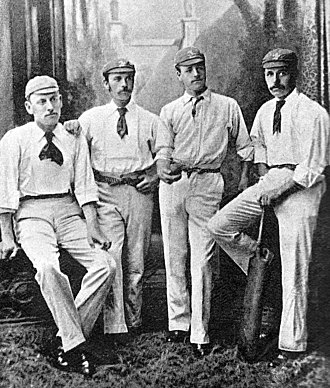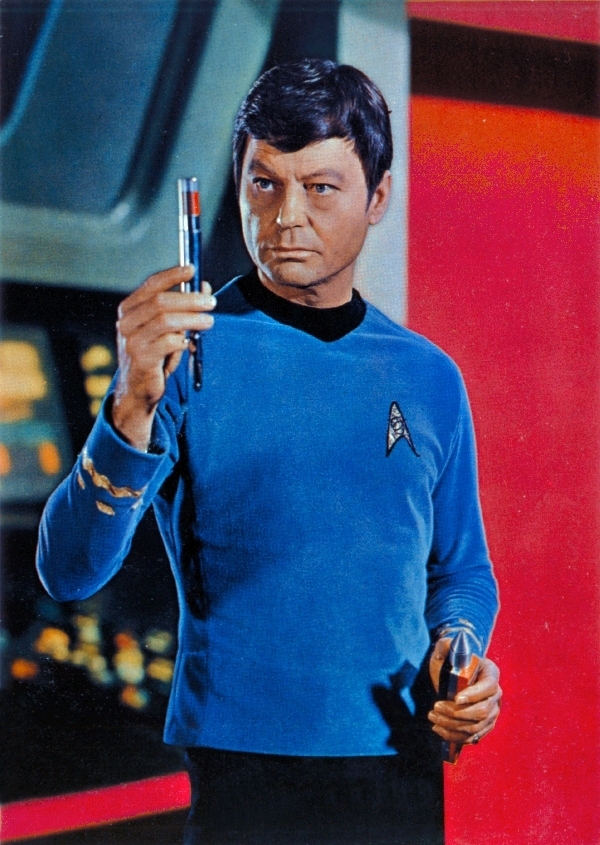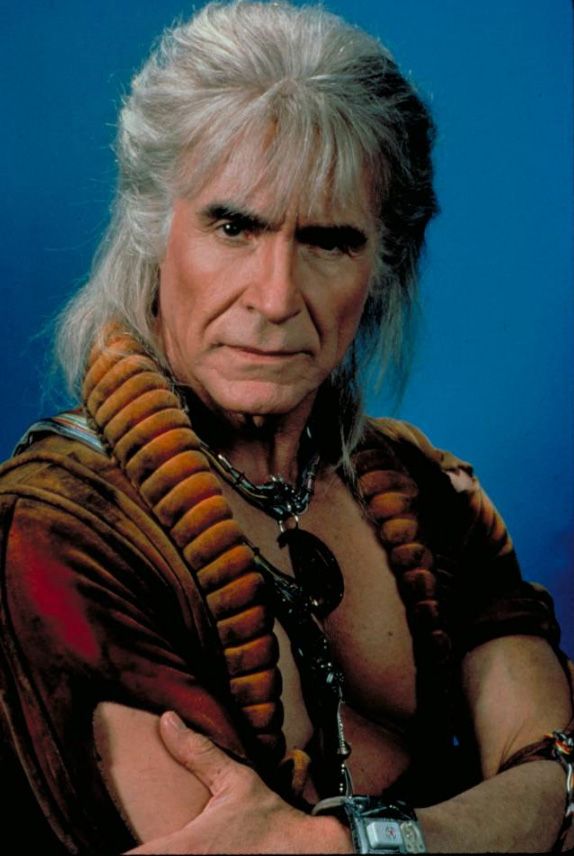1. Jack MacBryan

Jack earned his sole cap for England in the 4th Test at Old Trafford against South Africa in 1924. The match was ruined by rain and only 66 overs were possible over the whole 5 days. All of these overs Jack spent in the field, and he remains the only cricketer in Test history who scored no runs, took no wickets and took no catches without facing or bowling a ball. He was never selected for England again.
Despite this, Jack held a distinguished First Class record and was awarded the title of Wisden Cricketer of the Year in 1925. An accomplished hockey player, Jack was a member of the 1920 gold medal winning Great Britain Olympic team.
It was perhaps surprising he could do any of this however, as during the First World War Jack suffered a serious injury to his right arm, meaning he could barely throw a ball at all.
2. George Gibbons Hearne
Hot on Jack's heels however is the strapping young man on the far right of this picture.
George Hearne played just the one test for England at Newlands in the 1892 tour to South Africa. After bowling out SA for 97 on the first day, George failed to trouble the scorers coming in at number 4 in the England reply of 369. SA were then skittled again for 89, losing by an innings. George was never called up again meaning he never had the chance to begin his tally. Incidentally the only other England batsman not to make it into double figures in the innings, was George's brother Alec (second on the right), scoring 9 also playing in his only test innings for England.
His brother Frank (second left in this picture) also made his Test debut in this match, but bizarrely for South Africa. Frank had been playing for Western Province for some time before this and took advantage of the very relaxed qualification laws in the early days of Test cricket. He went on the play 6 tests for them.George Hearne played just the one test for England at Newlands in the 1892 tour to South Africa. After bowling out SA for 97 on the first day, George failed to trouble the scorers coming in at number 4 in the England reply of 369. SA were then skittled again for 89, losing by an innings. George was never called up again meaning he never had the chance to begin his tally. Incidentally the only other England batsman not to make it into double figures in the innings, was George's brother Alec (second on the right), scoring 9 also playing in his only test innings for England.
Completing this picture is elder brother Walter Hearne (1st left). The only brother not to have played Test cricket. All of the brothers had distinguished First Class careers for Kent.
3. Ken Meuleman (Australia)
Ken was another cricketing victim of an innings victory in his debut test. He opened the batting in Australia's first ever Test against New Zealand in 1946. Despite New Zealand becoming a Test playing nation in 1930, it came as a surprise to me that it was so long before they met their closest cricketing neighbours. Even after this tour, it would be another 28 years before they met in a Test match again. In an era where teams often had to sail for weeks to play cricket tours on the other side of the world, I would've assumed a (relatively) quick crossing of the Tasman sea would've been a fairly regular occurrence. But apparently not. Even though both teams were amateur, the problem lied with the huge gulf in quality between them, with Australia being far more established on the global scene. Perhaps rightly, this gulf was judged too large to make the sail worthwhile.
The gap in quality was certainly seen in Ken's only appearance in the baggy green.
In front of a huge crowd in Wellington, the home team were bundled out for just 42 in their first innings by an Australia team with 7 debutants (including the great Ray Lindwall). Ken then opened the batting but was cleaned bowled for 0 with the score on 9. With Australia declaring on 199-8, they then completed their rout, cleaning up the Kiwis for a paltry 54 in their second innings. Ken did at least get himself in the scorebook, catching the last wicket of the match off the bowling of the gloriously named Colin McCool.
At the end of his playing career Ken remained involved with grass roots cricket in Western Australia, mentoring and coaching some of their future stars, most notably Justin Langer. He founded a sports shop in Perth called Meuleman's Cricket Centre which is still open today, despite Ken's death in 2004.
4. Roy Park (Australia)
A sporting prodigy, Roy played both cricket and Australian Rules Football in Victoria.
He made his only Test appearance for Australia against England at the MCC in 1920, scoring a duck in his only innings.
A fantastic story is attached to this. It was reported that Roy's wife was knitting in the crowd when he walked out to bat, but dropped her knitting just as he was about to face his first ball. She bent down to pick it up as Roy got clean bowled, thus missing his entire Test batting career.
A fantastic story is attached to this. It was reported that Roy's wife was knitting in the crowd when he walked out to bat, but dropped her knitting just as he was about to face his first ball. She bent down to pick it up as Roy got clean bowled, thus missing his entire Test batting career.
He did manage to bowl an over of off spin in Englan's first innings, meaning that he did at least trouble the scorers slightly.
Outside of sport, Roy was doctor and only after his only Test did it emerge that the night before Roy had got no sleep as he was supervising a difficult birth. He also served with distinction during the First World War as a medic. Unfortunately his work commitments and bust ups with the Victorian cricketing authorities meant he only made a further 12 appearances for Victoria over the next 4 seasons which eventually lead to his retirement from the game.
5. Vijay Rajindernath (India)
Another One-Test Wonder, Vijay was one of 4 wicket keepers that India tried against Pakistan in their 1952-53 home series. He wasn't called upon to bat in either innings as India won by 10 wickets after declaring in their first innings. Poor Vijay also didn't take a single catch in either of Pakistan's fairly brief innings.
His only Test was memorable however. Even though no catches came his way, on a spin friendly pitch he managed to affect 4 stumpings in the match. He still holds the record for taking the most amount of stumpings in a completed Test career without taking a catch.
6. Nadeem Ghauri (Pakistan)
Nadeem has had a colourful cricketing history, despite being a member of the One-Test club. His sole appearance came in 1990 against Australia at the SCG, where he neither scored a run or took a wicket. He was out for a 5th ball duck batting at 11 in Pakistan's only completed innings, and bowled only 48 balls in the severely rain affected match where play was only possible on 2 days.
Upon retirement from his playing days, Nadeem became an umpire and stood in his first Test match at Dhaka in 2005 in a match between Bangladesh and Zimbabwe and has since officiated in 5 Tests, 43 ODIs and 4 T20Is and has been part of the ICC's elite panel of umpires. That is, until April 2013 when he was banned for 4 years by the ICC following a TV sting in India which allegedly showed Nadeem agreeing to accept money in return for making favourable umpiring decisions for certain players in a Sri Lankan league.
Notably Nadeem was also on the bus with the Sri Lankan cricket team that was attacked by gunman in a terrorist attack in 2009, which marked the end (mostly) of international cricket in Pakistan. Luckily he wasn't injured.
7. Lincoln Roberts (West Indies)
When Lincoln was selected by the West Indies for the 2nd Test against Australia at Sabina Park in 1999 he made history. He became the first cricketer from the island of Tobago to represent the West Indies in Test cricket. He batted at number 3, ahead of Brian Lara, despite only averaging 22 in First Class cricket. Unfortunately for Lincoln, like the others above him in this article he also didn't score a run. To rub it in further, he then had to sit on the side lines for the next day and half and watch Lara knock McGrath, Warne, Gillespie et al all round the park for a mammoth 213. He didn't bowl, didn't take a catch and wasn't selected again. Whatever monument the Tobago government were possibly planning to mark his historic selection probably didn't get much beyond the doodling stage..
8. Gerald Bond (South Africa)
All-rounder Gerald Bond had a promising and consistent early First Class career playing for Western Province in the 1930's. When the touring England squad arrived in 1938-39, he took 2 wickets against them (including the prized wicket of Wally Hammond) for Western Province in a warm up match. He was rewarded by being included in the South Africa XI for the first Test.
Unfortunately for Gerald and all concerned, the match was badly affected by rain. During England's first innings, he was used as the 6th bowler and given only 2 overs to bowl. He did not take a wicket. When it came to South Africa's turn to bat, instead of batting at 3 or 4 like he did for Western Province, Gerald found himself stuck down at number 9. When his chance in the middle eventually came he was of course, clean bowled first ball.
Poor old Gerald not only was never selected by South Africa again after this match, he also never played a First Class match again. Poor bloke.
9. Joseph Emile McMaster (England)
Joseph has earned a special place in this XI.
In 1889, South Africa were not yet recognised as a Test playing nation. England sent an understrength squad to tour there, which included a number of club players with little or no First Class experience. One of those players was Joseph. He played all the warm up matches, with his highest score being 34 against South Western Districts. He was selected for the second and final match against South Africa, where he picked up a golden duck batting at number 9 in England's first innings of 292. England then bowled out South Africa twice on the second day (for 47 and 43). And that was that.
Upon returning home from the tour, Joesph went back to Harrow and was never considered again. Therefore his entire Test career AND his entire First Class career consisted of just 2 days. He scored no runs, bowled no balls, took no catches and was on the field for just 76 overs and 4 balls.
10. Peter Allan (Australia)
Aussie seam bowler Peter Allen was another who played just the 1 test, but unlike the others above him in this XI (apart from the famous Jack MacBryan of course), he didn't bag a duck on his only appearance. He didn't need to strap the pads on at all.
He opened the bowling for Australia in the first Test at Brisbane in 1965-66 Ashes series. He actually did pretty well, taking 2-58 off 21 overs in the first innings to help bowl England out for 280 after Australia had declared on 448. He was only called upon to bowl 3 overs in the second innings as Australia won at a canter by an innings, losing just 6 wickets in the whole match.
Peter was subsequently dropped for the next Test in favour of the returning Alan Connolly. Perhaps aggrieved by his omission, he went back to Queensland and took 10-61 against Victoria in a First Class match, which still remains the 3rd best figures ever recorded in Australia. Having successfully caught the Test selectors eye, he was recalled for the 4th Test, but picked up and injury before the match. His replacement, Garth McKenzie took 6-48 and kept Peter out of the squad. Despite going on a tour to the West Indies with Australia in 1964-65, he wasn't selected and wasn't considered again.
11. The Unfortunate 9
I've decided to keep the number 11 spot for a very special 9 players.
These 9 players all have just the 1 Test cap. And they are the only players in Test history to have bagged a pair in their only Test appearance.
Fred Grace (England) 1880 vs Australia at The Oval
Clarence Wimble (South Africa) 1891-92 vs England at Cape Town
Percy Twentyman-Jones (South Africa) 1902-03 vs Australia at Cape Town
Percy "Plum" Lewis (South Africa) 1913-14 vs England at Durban
Cecil Dixon (South Africa) 1913-14 vs England at Johannesburg
Gordon Rowe (New Zealand) 1945-46 vs Australia at Wellington
Len Butterfield (New Zealand) 1945-46 vs Australia at Wellington
(Both Gordon and Len played in the same match as Ken Meueleman mentioned above.)
Rashid Patel (India) 1988-89 vs New Zealand at Bombay
(Notably, Rashid also once got himself in hot water for attacking an opponent with a stump in a Ranji Trophy match. Perhaps a story for another blog post..)
Gavin Hamilton (England) 1999-00 vs South Africa at Johannesburg
(Poor Gavin Hamilton - England fans of my generation will remember him as the Scotsman who was billed as the next star all-rounder. Unfortunately it never quite materialised for him.)
Percy "Plum" Lewis (South Africa) 1913-14 vs England at Durban
Cecil Dixon (South Africa) 1913-14 vs England at Johannesburg
Gordon Rowe (New Zealand) 1945-46 vs Australia at Wellington
Len Butterfield (New Zealand) 1945-46 vs Australia at Wellington
(Both Gordon and Len played in the same match as Ken Meueleman mentioned above.)
Rashid Patel (India) 1988-89 vs New Zealand at Bombay
(Notably, Rashid also once got himself in hot water for attacking an opponent with a stump in a Ranji Trophy match. Perhaps a story for another blog post..)
Gavin Hamilton (England) 1999-00 vs South Africa at Johannesburg
(Poor Gavin Hamilton - England fans of my generation will remember him as the Scotsman who was billed as the next star all-rounder. Unfortunately it never quite materialised for him.)






















